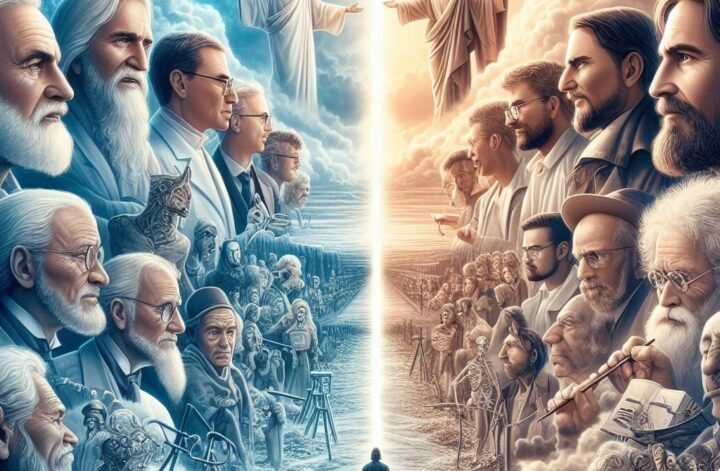John 1:1 is one of the well-known Bible verses: In the beginning was the Word, and the Word was with God, and the Word was God. It can be a puzzling verse. To many readers, it appears that John was poetic and cared little for precedence. But was he? Did John express a fresh revelation about the divine with this description, or did he have an Old Testament practice to rely on? The latter is the case.
Whereas today, the “word of God” can mean anything from a preacher’s sermon to the Bible, the phrase had other uses in the Hebrew Bible. Today, we are used to thinking about the “word of God” primarily as an AUDITORY thing. In the Old Testament, however, the phrase is also used VISUALLY – which informs John’s writing.
One instance of this visual use is found in 1 Samuel 3. This chapter contains several visual references to the “word of God,” but years of contrary teachings make it hard to see most of them. Hence, I shall begin with the more apparent instances and work backwards.
The very last verse reads (1 Sam 3:21): “And the Lord appeared again at Shiloh, for the Lord revealed himself to Samuel at Shiloh by the word of the Lord.”
Of course, Shiloh is where 1 Samuel 3 was set. God revealed himself to Samuel by (or as) the “word of God.” But this “word of God” is not a (mere) message or speech. It is something that can be seen. Indeed, the first verse of 1 Samuel 3 hints at this:
“Now the boy Samuel was ministering to the LORD in the presence of Eli. And the word of the LORD was rare in those days; there was no frequent vision.”
Notice how the second part contrasts “the word of the LORD” being rare in those days with VISIONS (not voices or messages) being rare. This “word of the LORD” is a visually perceptible entity. Next, the narrator tells us something interesting. After God had called Samuel twice, and he mistook the calling voice for Eli’s both times, we get this explanation from the narrator:
“Now Samuel did not yet know the Lord, and the word of the Lord had not yet been revealed to him. (1 Samuel 3:7 ESV)
Let’s dwell on that simple commentary a bit. Recall that Hannah, Samuel’s mother, gave him up to serve at the temple as soon as he was weaned. So, Samuel had been living at the temple in Shiloh (and helping with temple functions) for a while. So, when we read that “the word of the LORD had not yet been revealed to him,” that could not conceivably mean that Samuel hadn’t been taught from the Scriptures. So, what could that comment mean then? Here it is. The “word of the LORD” refers to Yahweh himself. To say that the word of the LORD had not been revealed to Samuel is to say that Yahweh had not (literally) revealed himself to Samuel – as he did to Moses. Eventually, the LORD revealed himself to Samuel in verse 10:
And the LORD came and stood, calling as at other times, “Samuel! Samuel!” And Samuel said, “Speak, for your servant hears.”
Again, notice that God “came and STOOD.” This isn’t merely an auditory exchange. It is also a visual one. This further helps us understand the last verse that says God revealed himself by “the word of the LORD” to Samuel. Whatever that means must include the piece that says God “came and stood.” The “revealing” here is visual.
This 1 Samuel passage is one of several “word of the LORD” passages in the Old Testament. Indeed, the second example we will consider next is better known among churchgoers.
Jeremiah 1:4-9 ESV
[4] Now the word of the Lord came to me, saying, [5] “Before I formed you in the womb I knew you, and before you were born I consecrated you; I appointed you a prophet to the nations.” [6] Then I said, “Ah, Lord God! Behold, I do not know how to speak, for I am only a youth.” [7] But the Lord said to me, “Do not say, ‘I am only a youth’; for to all to whom I send you, you shall go, and whatever I command you, you shall speak. [8] Do not be afraid of them, for I am with you to deliver you, declares the Lord.” [9] Then the Lord put out his hand and touched my mouth. And the Lord said to me, “Behold, I have put my words in your mouth.
What exactly visited Jeremiah? Well, it isn’t very likely to be merely some divine message. On the contrary, Jeremiah was visited by a person. Consider the following points from the passage:
1. The passage doesn’t say that the “word of the LORD” came to Jeremiah via some messenger. No intermediaries like an angel or a prophet were mentioned.
2. This “word of the LORD” that visited Jeremiah could talk, “SAYING…” (verse 4).
3. Notice how Jeremiah responded to the initial message of “the word of the LORD”: “Ah, LORD GOD!“ (verse 6). Jeremiah took the speaking “word of the LORD” as God himself.
4. THAT same “word of the LORD” character has a hand AND touches Jeremiah’s mouth. That is, this character is visible.
5. Interestingly, this word of God character, now identified as the LORD himself, put his words (i.e., the words of God) in Jeremiah’s mouth (verse 9).
That last point deserves zooming in on a bit. If the word, singular, of God that visited Jeremiah was a mere divine instruction or message, well, it sure contained more than a word. And if it was a message, why was there a need to put more words in Jeremiah’s mouth afterward? Was the original “word of the LORD” insufficient? No, the “word of the LORD” in the passage is Yahweh himself. The words later put in Jeremiah’s mouth constitute the message Jeremiah must deliver to the people.
This “word of the LORD” theme is one of a few ways that the Hebrew Bible conveys the idea of a plurality in the Godhead, something that first-century Jews would later expand into what we now call the Holy Trinity. John, himself a Jew, knew this Jewish thought. When he wrote John 1:1, he didn’t express anything new. He merely identified the risen Jesus as the “word of Yahweh” that passages like Jeremiah 1 and 1 Samuel 3 talk about.
The Gospel of John is well known for its high christology. But it is important to note that John didn’t make up the idea of divine plurality. He didn’t make Jesus God. The Hebrew Bible is replete with descriptions of a plurality in the Godhead. John merely identified Jesus as the “word of Yahweh” of the Old Testament. And if Jesus is the word of the LORD, then he must have the divine attributes that John summarizes in John 1:1.




